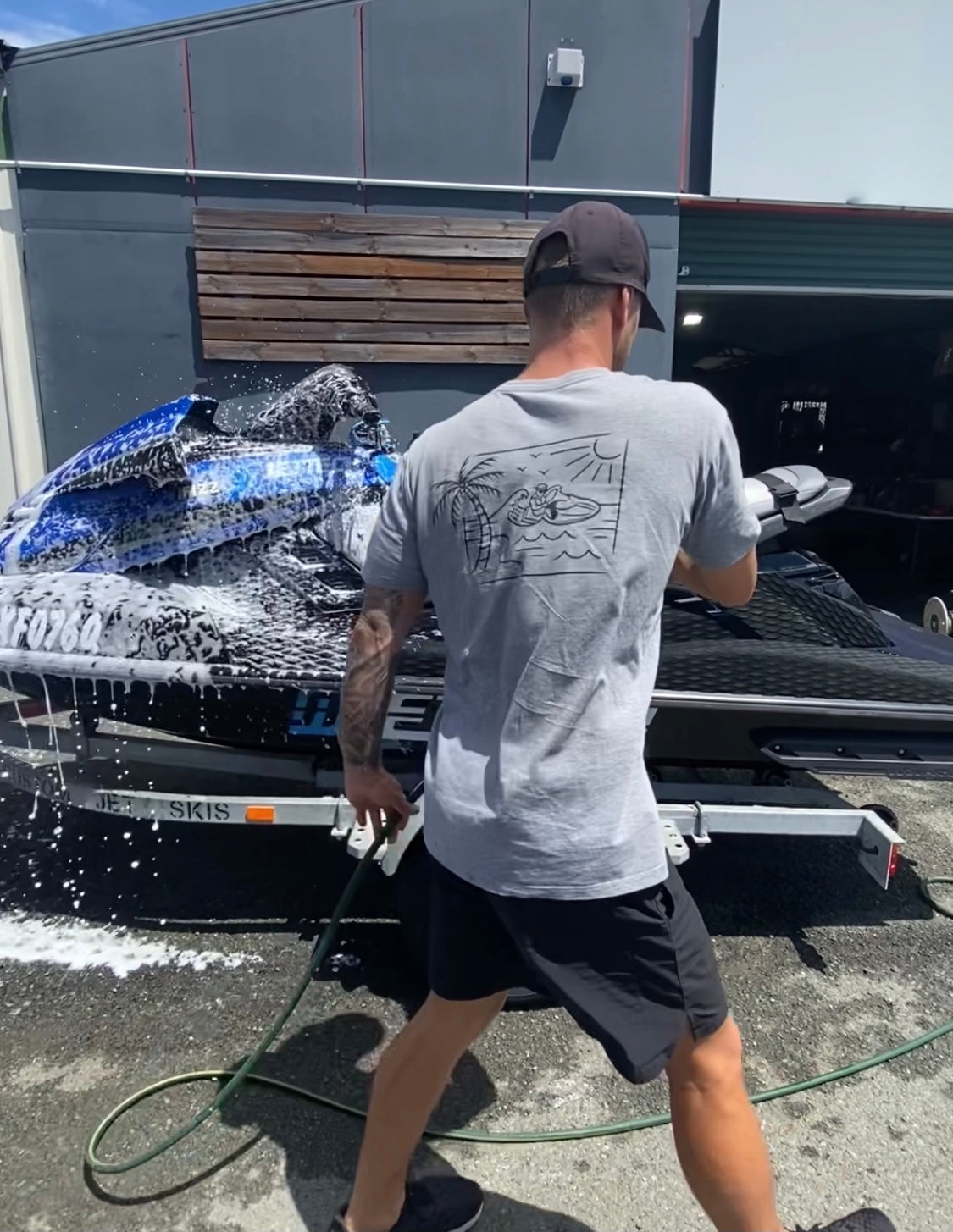There is one golden rule: after every ride, always clean the whole Jet ski before packing it away.
Open the hood, glove box and storage areas, and remove the seats and place them on a foam mat to avoid damage on the upholstery. Sometimes it is good to sit them upright as this allows water to drain from the seat.
Remove the bungs from the hull at the back of the jet ski, and If you have a bung in the storage or glove box, consider removing them completely as it is good to wash in those areas so mould/gunk does not build up.
Washing:
- Chock the trailer wheels carefully. Place the jockey wheel onto a crate or bucket to lift the front of the ski allowing the hull to drain.
- Hose the ski down from front to the rear, inside and outside. Ensure that water does not enter the fuel breather, air intake or coils, and electrical areas. No need to do this with a pressure washer as you may damage electrical components.
- Bring out your soapy bucket and sponge and put some elbow effort into washing down the entire jet ski
- Don’t forget to clean your tubs and seats, especially underneath to wash out salt and sand.
- Pay attention to cleaning out the pump area at the back and spray through the prop to clean the intake area free of sand or small rocks from the boat ramp to avoid damage to the prop and liner in the jet pump. You may need to raise the reverse bucket to gain clear access and avoid spraying into the exhaust outlet.
- For any remaining water in the hull, if the jet ski is going to be siting for a while it is advised to remove the left over water with a sponge.
- Don’t forget your trailer, this is also just as important, specially getting in behind the hubs of the wheels as this is the first spot to always start rusting. Attack the trailer from each side so water hits the surface areas on to different angles to get as much salt off as possible.
Flush Engine:
- Even after fresh water use, flushing is recommended to remove any sand and algae weed from the cooling system and pump.
- Place your ski back into a level position and have the hose ready to plug into the jet ski. Yamahas will come with an adapter fitting approximately 30cm long that plugs into a fitting under the rear seat. On Sea-Doo’s you plug the hose straight onto a fitting under the transom next to your jet pump at the rear of the ski.
- VERY IMPORTANT to turn on the Jet Ski before turning on the water, the jet ski is fine to run with no water for 10 seconds.
- With water flowing run the jet ski for 3 or so minutes allowing for the jet ski to be warmed up for a thorough flush.
- VERY IMPORTANT to turn off the water first and allow the jet ski to run for an extra 5-10 seconds with a few light throttle squeezes to push out any remaining water in the system. The reason you turn the water on last and turn the water off first in this process, is to avoid water filling up the exhaust system and making its way into the engine.
- DO NOT throttle squeeze to spit out salt water at the ramp before flushing, as it will “cook” the salt into the internal components.
Post-ride checks:
- Ensure your engine is level and the engine has been idle for at least 2 minutes.
- Pull out the dipstick to check the oil by wiping it clean and re-dipping. It should sit within the manufacturer’s specifications indicated in your owner’s manual. If it has any milkiness to it you should contact your service agent as soon as possible, as this means water has made its way in there and extreme damage can occur.
- If the oil level has dropped, check the oil filter for leaks and look over the motor. If there are no leaks or apparent damage, refill to the correct level with the specified oil. If you are unable to explain the loss of oil, contact your service agent.
- If your ski has closed-loop cooling (Sea-Doo’s only) check the coolant level at the same time.
- Using a torch, look into the hull and check for any disconnected hoses or items that may have come loose.
- Inspect the pump at the back to look for any damage to the prop or liner/wearing.
- Inspect the outside of the hull for any damage from rocks, as this may worsen if left un-repaired.
- Check over your trailer for tyre and bearing condition, corrosion build-up (especially around the forgotten jockey wheel/hitch area) and the winch strap condition.
- Always refuel on your way to the ramp to ensure fresh fuel and a full tank. Use the best quality fuel as much as possible.
- Check your engine hours to make sure a service is not due.
With proper care, a Jet Ski can stay in great condition and last for a decade or two with getting up to a 1000 hours out of the engine.

